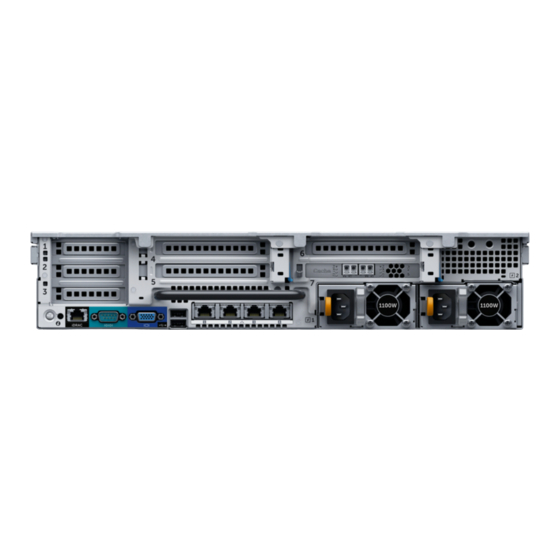
Summary of Contents for Dell SC9000
- Page 1 Dell Storage Center SC9000 Storage System Owner's Manual Regulatory Model: E09J, E10J Regulatory Type: E09J001, E10J001...
- Page 2 WARNING: A WARNING indicates a potential for property damage, personal injury, or death. Copyright © 2016 Dell Inc. All rights reserved. This product is protected by U.S. and international copyright and intellectual property laws. Dell and the Dell logo are trademarks of Dell Inc.
-
Page 3: Table Of Contents
SC9000 Monitoring and Diagnostics ..........................9 LCD Panel Features ........................... 9 Home Screen ............................10 Setup Menu ............................. 10 View Menu 2 Replacing SC9000 Storage System Components.........11 ..........................11 Safety Precautions .......................11 Installation Safety Precautions ......................11 Electrical Safety Precautions ..................... 12 Electrostatic Discharge Precautions ...................... -
Page 4: About This Guide
Preface About this Guide This guide describes how to perform service and maintenance on the SC9000 storage system. Revision History Document Number: 680-101-001 Revision Date Description October 2015 Initial release May 2016 Made editorial changes Audience The information provided in this guide is intended for use by Dell end users. -
Page 5: About The Sc9000
System, application software (Dell Storage Client), and management of RAID storage. Each storage controller includes two Intel Xeon CPUs, a cache card, an Integrated Dell Remote Access Controller 8 (iDRAC8), a four‐port Intel network daughter card, and up to six IO cards installed in three full‐height slots and three low‐profile slots. -
Page 6: Front Panel Features And Indicators
The power button controls the power supply output to the system. NMI button Not used for the SC9000. System identification The identification buttons on the front and back button panels can be used to locate a particular system within a rack. -
Page 7: Back Panel Features And Indicators
Filler plate Covers empty bay. ― vFlash media card slot ― Not used for the SC9000. iDRAC USB Connects USB devices to the system or provides access to the iDRAC Direct features. The USB management port is USB 2.0-compliant. Management USB Connects USB devices to the system. - Page 8 1100 W, 100–240 V AC, autoranging, 50/60 Hz Cache card Improves the performance of the storage system ― by temporarily storing data before it is written to disk. Power supply unit 1100 W, 100–240 V AC, autoranging, 50/60 Hz ― (PSU2) About the SC9000...
-
Page 9: Sc9000 Monitoring And Diagnostics
The Storage Center Operating System generates alert messages for temperature, IO card, fan, and power conditions for Storage Center components. Use the Dell Storage Client to view these alerts. The SC9000 storage controller generates system messages that notify you of a possible problem with the storage controller. System messages are recorded in the System Event Log (SEL) and they may also appear in an abbreviated form on the LCD panel. -
Page 10: Setup Menu
Set home submenu of the Setup menu. Temperature Displays the temperature of the system in Celsius or Fahrenheit. The display format can be configured in the Set home submenu of the Setup menu. About the SC9000... -
Page 11: Replacing Sc9000 Storage System Components
Always follow these safety precautions to avoid injury and damage to Storage Center equipment. If equipment described in this section is used in a manner not specified by Dell, the protection provided by the equipment could be impaired. For your safety and protection, observe the rules described in the following sections. -
Page 12: Electrostatic Discharge Precautions
The resulting electrical discharge can damage electronic components and printed circuit boards. Follow these guidelines to protect your equipment from ESD: • Dell recommends that you always use a static mat and static strap while working on the storage controller. •... -
Page 13: Pre-Replacement Procedures
Perform the procedures described in this section before replacing the rack rails. Send Diagnostic Data Using Dell SupportAssist Use the Dell SupportAssist to send diagnostic data to Dell Technical Support Services. Use the Dell Storage Client to connect to the storage system. -
Page 14: Replacing Rack Rails
Plug the power cables into the PSUs of the storage controller. Turn on the storage controller by pressing the power switch on the storage controller. Use the Dell Storage Client to make sure that the replacement part is recognized and shown as up and running. -
Page 15: Technical Specifications
Technical Specifications Processor Processor type Two Intel Xeon 3.2 GHz 8 core processors Power AC power supply unit (PSU) per power supply Wattage 1100 W 4100 BTU/hr maximum (1100 W PSU) Heat dissipation NOTE: Heat dissipation is calculated using the power supply unit wattage rating. 100–240 V AC, autoranging, 50/60 Hz Voltage Expansion Bus... - Page 16 75.58 cm (29.75 inch) Maximum configuration 44 lb weight Environmental For additional information about environmental measurements for specific storage system configurations, see dell.com/environmental_datasheets. Temperature Storage –40° to 65°C (–40° to 149°F) Continuous operation 10°C to 35°C with no direct sunlight on the equipment.
- Page 17 Environmental Operating 10% to 80% with 29°C (84.2°F) maximum dew point Maximum vibration Operating 0.26 G at 5 Hz to 350 Hz (all operation orientations). Storage 1.88 G at 10Hz to 500 Hz for 15 min (all six sides tested). Maximum shock Operating Six consecutively executed shock pulses in the positive and negative x, y, and...
- Page 18 The operating temperature specified is for a maximum altitude of 3050 m (10,000 ft). • Redundant power supplies are required. • Peripheral cards that are not Dell-qualified are not supported. • Peripheral cards greater than 25 W are not supported.










Need help?
Do you have a question about the SC9000 and is the answer not in the manual?
Questions and answers